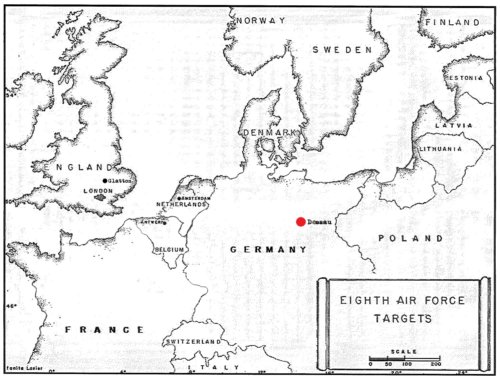TARGET: AERO-ENGINE FACTORY
DESSAU, GERMANY
28 MAY, 1944

The Group attacked the aero-engine factories located at Dessau, Germany. The target was the center of the Junkers Aircraft Organization. This organization was primarily engaged in the development and in the experimental work on new as well as existing aircraft. The target had one of the highest priorities of all the remaining targets in Germany. For the second straight day, the 457th felt the wrath of the Luftwaffe.
The bomber stream consisted of fifteen combat wings. The 94th Combat Wing was the last wing in the 1st Division formation. The 457th formation, led by Major George C. Hozief as Air Commander with Lt. Charles D. Brannan as pilot, formed the lead box in the 94th Combat Wing.
The flight was uneventful until the bomber stream separated at a point northeast of Brunswick. Then, the fifteen wings took up separate courses for the attacks on their separate targets. The Group was attacked at the IP by large forces of Me 109s and FW-190s.
The ship piloted by Lt. Clyde B. Knipfer, flying his 24th mission, was hit and dropped out of formation with No. 1 and No. 2 engines blazing. Lt. Knipfer and crew parachuted to the ground where all were picked up by the Germans and held as prisoners of war.
A second mass frontal attack was made on the Group. Waves of Ju-88s and Me-109s attacked from the side followed immediately by Me-109s and FW-190s. Lt. Rudolph Stohi’s craft took a direct hit and left the formation. The craft crashed after the crew bailed out. One crewman died.
Lt. Bernard V. Conners’ craft came back on one engine, two engines having been lost in the target area. Three cylinders on a third engine had been punctured by enemy flak. Conners had flown back at an air speed of 115 to 135 miles per hour, with just enough power to keep airborne.
Prior to reaching the target, the craft of the Air Commander, Major George C. Hozier, was attacked. One engine was damaged and set ablaze, and the wing fuel tank was punctured seriously, endangering the safety of the craft. In spite of the damaged condition of the craft, Major Hozier maintained the lead and when he found it impossible to visually bomb the Primary target, after making two 360 degree turns, led the Wing to the secondary target, an aircraft factory at Leipzig and bombed With excellent results. For his gallant leadership, sound judgment and devotion to duty, Major Hozier was awarded the Silver Star. In addition to the enemy fighter opposition, the antiaircraft fire was moderate but accurate. A number of planes suffered damage. Gunners received credit for destroying one enemy aircraft and damaging five.
